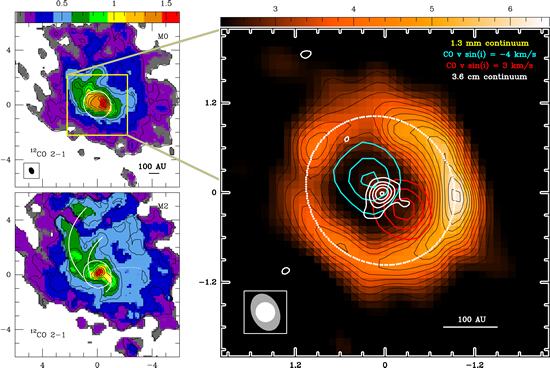Research Gallery > The SAO/ASIAA Submillimeter Array (SMA)
Research Gallery
The SAO/ASIAA Submillimeter Array (SMA)
| The circumstellar disk of AB Aurigae: evidence for envelope accretion at late stages of star formation? |
|
Image Credit: Tang et al

Left panels: 12CO 2-1 integrated intensity map (M0, upper-left panel) and the velocity dispersion map (M2, lower-left panel) toward the circumstellar disk of the Herbig Ae star AB Aurigae from the PdBI observations. Four molecular spiral-like structures are identified based on these two maps and are marked as white arcs in the M2 map.
Right panel: dense disk traced with the thermal dust continuum emission at the wavelength of 1.3 mm (shown in color scale and in black contours). The white contours at the stellar location is the free-free emission at the wavelengths of 3.6 cm. The blue and red contours represent the 12CO J=2-1 line emission at the projected velocity of -4 and 3 km/s with respect to the systematic velocity.
|
| Although most disks are found to be Keplerian on scales of 100s AU, more and more disks are found to have complex structures, such as the large cavities, asymmetries and spiral features observed with millimeter and near-infrared continuum. We successfully trace the molecular spirals with 12CO J=2-1 line around the system AB Aurigae for the first time using the combined Submillimeter Array, IRAM 30-m and the Plateau de Bure Interferometry data. The dense disk is also traced using the thermal continuum emission at a wavelength of 1.3 mm.
At 1.3 mm, this disk is resolved into an inner disk and an outer ring, which has a radius of 90 AU. Associated with the inner disk detected at 1.3 mm, the detection of the free-free emission at 3.6 cm further supports the existence of the inner disk. The high velocity 12CO 2-1 emission at the stellar location suggests that the inner disk is not free of molecular gas. The most striking features are the large scale spirals within the circumstellar matter traced in the 12CO J=2-1 line. Spectra at these spiral locations suggest that the excess gas components on the spirals are in bulk motion with velocity deviating from the rotating disk. We further studied the kinematics of these spiral-like features. Surprisingly, the excess of CO gas along the spirals is apparently counter-rotating with respect to the gaseous disk. This behavior is unexpected from standard disk and accretion models.
The wide dust gap, the warped disk, and the asymmetric dust ring (intensity contrast is up to 3 on the ring), suggest the existence of, at least, one undetected companion with a mass of 0.03 Msun at a radius of 45 AU. The different spirals would likely require multiple perturbing bodies. Tidal interactions can explain the inner disturbances of the disk but cannot explain the apparent counter-rotation of the gas in the outer spirals. A better explanation is that these motions are due to very small amounts (10-6 solar mass) of inhomogenously accreting gas infalling preferentially well above/or below the main disc plane from the surrounding remnant envelope along quasi parabolic/spiral like trajectories. Our study indicates that accretion can play a role in shaping the disk even at rather late stages as the age of AB Aur is estimated to be ~4 Myr. (Tang et al. 2012, AA, 547, A84). |
 asiaa.sinica.edu.tw Media Request: epo
asiaa.sinica.edu.tw Media Request: epo asiaa.sinica.edu.tw
asiaa.sinica.edu.tw 
